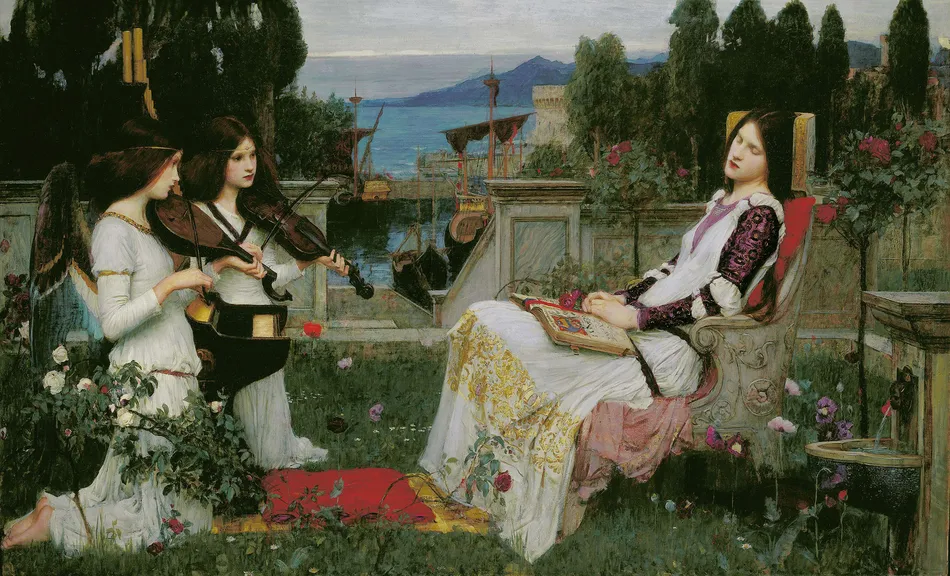-

St Cecilia
A saint sits enraptured, fingers hovering above the strings. An angel leans close, whispering divine melodies only she can hear. The air hums with silent music, her face alight with celestial inspiration. Golden light spills across her robes, blurring the line between earthly devotion and heavenly communion.
-

The Fruit Seller
A woman arranges ripe peaches in her market stall, their golden skins catching the morning light. Around her, baskets overflow with cherries and plums, their colors vivid against the worn wood. The air hums with quiet commerce, the simple rhythm of daily life unfolding in this corner of the marketplace.
-

Under the orange tree
A woman sits beneath the gnarled branches of an orange tree, sunlight dappling her dress. The fruit hangs heavy, their scent mingling with warm earth. She leans slightly, as if listening to the leaves whisper—a quiet moment suspended between shade and gold.
-
 (1806)-full.webp)
An Interesting Story (Miss Ray) (1806)
A young woman leans forward, lips parted as if mid-sentence, her eyes alight with some unspoken tale. The folds of her dress catch the light, soft shadows pooling around her eager posture. There’s mischief in her expression—whatever story she’s telling, you’d lean closer to hear it.
-
-full.webp)
Vase of Flowers (c. 1905)
A vase overflows with blooms—soft petals blur into dreamlike hues, their forms dissolving at the edges. The flowers seem to breathe, caught between reality and something stranger, as if they might fade into the air or grow roots through the table.
-
-full.webp)
Foreground study on the Mediterranean (1893)
Sunlight glints off the Mediterranean waves, brushing the rocky shore with gold. A lone shrub clings to the cliffside, roots gripping stone as the sea wind tugs at its leaves. The horizon stretches wide, empty but for the shimmering line where water meets sky.
-
-full.webp)
Friede (1910-1920)
A woman’s face emerges from shadow, eyes closed in quiet surrender. Golden light traces her features, softening the sharp lines of sorrow. Not triumph, not despair—just stillness, as if she’s listening to something beyond the frame. The title whispers its promise: *Peace*. But whose? And at what cost?
-
-full.webp)
Young Woman in Black (1902)
A woman in a black dress meets your gaze, her expression unreadable. The dark fabric contrasts sharply with her pale skin, drawing you into the quiet intensity of her presence. There’s a story in her stillness, but she isn’t telling—yet.
-
-full.webp)
Mädchen mit Puderquaste (circa 1925)
A girl holds a powder puff, her gaze distant. The soft brush contrasts with the sharp angles of her face, caught between youth and something darker. The colors hum with quiet tension, a portrait that lingers just beyond reach.
-
-full.webp)
Atlas państwa zwierzęcego Pl.83 (1905)
A meticulous engraving of the animal kingdom, where each creature is etched with scientific precision—fur, feather, and scale rendered in stark black lines against the page. The composition hums with quiet order, a taxonomy frozen in ink.
-

Romeo and Juliet
A final embrace, desperate and tender. The dim light catches their intertwined hands, the dagger’s gleam. Love and fate collide in this silent moment—Shakespeare’s tragedy made flesh, frozen in brushstrokes. No words, just the weight of what’s lost.
-
-full.webp)
Rhombosolea tapirina _ greenback flounder (before 1870)
A flat, mottled body lies still against the seabed—greenback flounder, perfectly disguised. Its asymmetrical eyes peer upward, waiting. The delicate watercolor strokes mimic the dappled light filtering through shallow waters. One wrong move, and the illusion shatters.
-
-full.webp)
Abbildungen zu Oken’s Allgemeiner Naturgeschichte für alle Stände Pl.005 (1841)
Delicate veins trace across broad leaves, their edges curling like parchment. Stems twist upward, bearing clusters of tiny blossoms—each petal rendered with precise, inked lines. A hidden world of texture and form emerges from the page, inviting closer study of nature’s intricate designs.
-
-full.webp)
The Roping (1914)
A cowboy leans low in the saddle, rope taut as his horse digs in. Dust swirls around them, the moment stretched thin between control and chaos. The horse’s muscles strain, eyes wild—caught in the raw tension of the throw.
-full.webp)